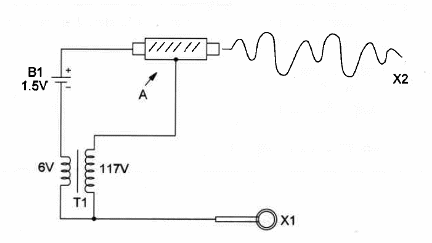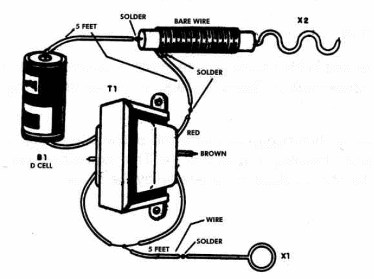This circuit puts your manual skills to a Lively test.
As shown in the schematic diagram, the circuit has a small Ioop that you must navigate around a wire.
The object of the game is to guide the Ioop over the weaving course without touching the wire.
A slight misdjudgement or quiver of the hand and the ring will contact the weaving wire, enabling the circuit that will produce a noticeable (but inoffensive) shock!
The skiII required to play the game depends largely on the size of the Ioop and the degree of twist and turn in the wire.
Scoring is a matter of counting the number of times the player is affected by a shock! The person with the Iowest total (or no touch) wins.
The circuit is powered from a D cell, as the current drain is high when the Ioop touches the wire. When not in use, don't Ieave the ring and wire together.
This will cause the battery to run down in a short time.
A circuit diagram of the device is shown in figure 1.

The heart of the proiect is the transformer that converts 1.5 VDC into high-voltage pulses up to 400 volts.
A mechanical view of the mounting is shown in Figure 2.

All the components can be housed in a small plastic box.
Wires to the loop and weaving wire should be 2 or 3 feet Iong to prevent puII-outs when the player is struck.
Observe the isolation between the points where the player touches and the weaving wire. The two wires that connect X2 should be twisted.
T1 is any smaH transformer with a 117 VAC primary, and secondary coil ranging between 3 and 9V.
Current drain can range from 100 to 500 mA when the wire touches the Ioop.
Test Your Nerves
T1 - Any transformer with a 117 VAC coiI and Iow-voltage secondary - see text
B1 -1.5V - D cell
X1 - Loop - see text
X2 - Weaving wire - see text
Ideas to Explore
To get better performance or to learn more about the circuit:
Explain why the transformer does not operate with DC but that this project is able to generate high voltage using that device.
What happens if the Ioop is placed together with the weaving wire? Why it is necessary to avoid this condition?
Science projects:
Changes in the project can be made to generate high voltage from cells in experiments. Nerve stimulation can be tried using this simp¡e circuit.
Neon or fluorescent Iàmps wired between the Ioop and wire wiIl flash when the Ioop and wire touch. This experiment can be used to prove that high voltage is generated by the circuit.




